Wir benötigen Ihre Einwilligung zur Verwendung der einzelnen Daten, damit Sie unter anderem Informationen zu Ihren Interessen einsehen können. Klicken Sie auf "OK", um Ihre Zustimmung zu erteilen.

Normen ETSI - Europäisches Amt für Standardisierung in Telekommunikationen - Seite Nr. 5922
ETSI – Europäisches Amt für Standardisierung in Telekommunikationen (ETSI) bildet global anwendbare Normen für Informations- und Kommunikationstechnologien (ICT) inkl. fester, mobiler Technologien, Funktechnologien, konvergierter Technologien, Sende- und Internettechnologien.
Fixed Radio Systems; Point-to-multipoint equipment; Point-to-multipoint digital radio systems in frequency bands in the range 24,25 GHz to 29,5 GHz using different access methods; Part 5: Multi-Carrier Time Division Multiple Access (MC-TDMA) methods
Die Norm herausgegeben am 23.10.2001
Ausgewählte Ausführung:Alle technischen Informationen anzeigen
Fixed Radio Systems; Point to Multipoint Antennas; Antennas for point-to-multipoint fixed radio systems in the 11 GHz to 60 GHz band; Part 1: General aspects
Die Norm herausgegeben am 14.6.2000
Ausgewählte Ausführung:Alle technischen Informationen anzeigen
Fixed Radio Systems; Point to Multipoint Antennas; Antennas for point-to-multipoint fixed radio systems in the 11 GHz to 60 GHz band; Part 1: General aspects
Die Norm herausgegeben am 7.8.2001
Ausgewählte Ausführung:Alle technischen Informationen anzeigen
Fixed Radio Systems; Point to Multipoint Antennas; Antennas for point-to-multipoint fixed radio systems in the 11 GHz to 60 GHz band; Part 2: 24 GHz to 30 GHz
Die Norm herausgegeben am 14.6.2000
Ausgewählte Ausführung:Alle technischen Informationen anzeigen
Fixed Radio Systems; Point to Multipoint Antennas; Antennas for point-to-multipoint fixed radio systems in the 11 GHz to 60 GHz band; Part 2: 24 GHz to 30 GHz
Die Norm herausgegeben am 14.11.2000
Ausgewählte Ausführung:Alle technischen Informationen anzeigen
Fixed Radio Systems; Point-to-Multipoint Antennas; Antennas for point-to-multipoint fixed radio systems in the 11 GHz to 60 GHz band; Part 2: 24 GHz to 30 GHz
Die Norm herausgegeben am 3.6.2002
Ausgewählte Ausführung:Alle technischen Informationen anzeigen
Fixed Radio Systems; Point to Multipoint Antennas; Antennas for point-to-multipoint fixed radio systems in the 11 GHz to 60 GHz band; Part 3: Multipoint Multimedia Wireless System in 40,5 GHz to 43,5 GHz
Die Norm herausgegeben am 7.8.2001
Ausgewählte Ausführung:Alle technischen Informationen anzeigen
Fixed Radio Systems; Point-to-Multipoint Antennas; Antennas for multipoint fixed radio systems in the 11 GHz to 60 GHz band; Part 4: 30 GHz to 40,5 GHz
Die Norm herausgegeben am 2.12.2003
Ausgewählte Ausführung:Alle technischen Informationen anzeigen
Fixed Radio Systems; Point-to-point equipment; Plesiochronous Digital Hierarchy (PDH); Low and medium capacity and STM-0 digital radio system operating in the frequency bands in the range 3 GHz to 11 GHz
Die Norm herausgegeben am 24.12.1999
Ausgewählte Ausführung:Alle technischen Informationen anzeigen
Fixed Radio Systems; Point-to-point equipment; Plesiochronous Digital Hierarchy (PDH); Low and medium capacity and STM-0 digital radio system operating in the frequency bands in the range 3 GHz to 11 GHz
Die Norm herausgegeben am 11.7.2001
Ausgewählte Ausführung:Alle technischen Informationen anzeigen
Brauchen Sie Hilfe?


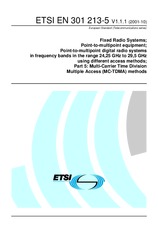
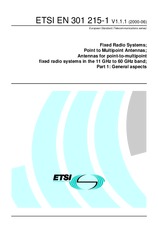
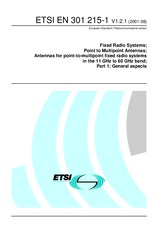
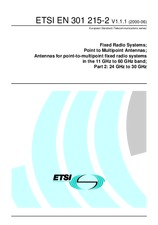
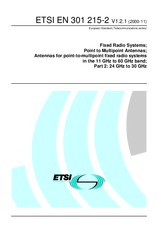
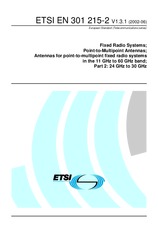
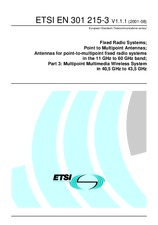
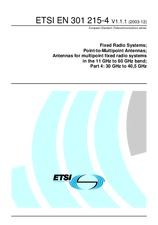
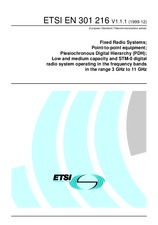
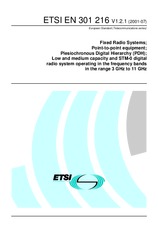
 Cookies
Cookies
